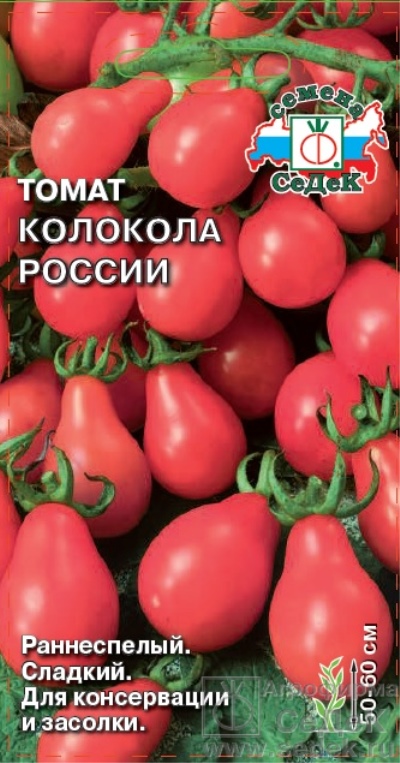
- Authors: Zhidkova V.A., Mikhed V.S., Altukhov Yu.P., Arkhipova T.P., Groshenko A.P., Zvyagintsev V.K., Zhmenya A.A. (FGBUN Institute of General Genetics named after N . I. Vavilova)
- Year of approval: 2000
- Name synonyms: Kolokola Rossii, Russian bells
- Category: grade
- Growth type: determinant
- Appointment: fresh consumption, for whole fruit preservation
- Ripening period: early
- Ripening time, days: 103-108
- Growing conditions: for open ground, for film greenhouses
- Marketability: high
Although the bell ringing is not to everyone's taste, every farmer wants to grow attractive tomatoes in his beds. But this is not so easy to achieve, even if you use the proven Bell of Russia variety. Knowing exactly about it will be very helpful.
Breeding history
The Bells of Russia were created in the most difficult period for breeding work - the 1990s. Despite this, the variety trials were successfully completed. The official registration of the new tomato took place in 2000. The development was carried out at the Vavilov Institute of General Genetics. At least 7 prominent specialists are known to have supervised this project.
Description of the variety
The plant has 2 official synonyms - Kolokola Rossii, Russian bells. It is characterized by determinant dynamics of development. Growing is possible both in ordinary vegetable gardens and in greenhouses under the film.
Other important features:
- bushes grow to a maximum of 0.45-0.5 m;
- the number of leaves is moderately large;
- the stem is strictly straight;
- branching is moderately expressed;
- the bushes are compact, covered with light green foliage;
- the stem will definitely develop.
The main qualities of the fruit
Young berries are light green in color. As they develop further, they will turn pink and acquire more and more expressive colors. The weight of the fruits is on average 0.052-0.055 kg, that is, they belong to the cherry category. The shape of a tomato is very similar to a pear, and a special "nose" is also noted. In brushes, 6-7 tomatoes of a high degree of keeping quality develop, first over 6-7 leaves, and then every 1-2 leaves.
Taste characteristics
The bells of Russia tomato is sweet to taste. Its pulp is not only saccharine, but also very dense. The skin on the surface is smooth, but has no particular effect on the perception of taste.
Ripening and fruiting
Bells of Russia can please summer residents with a harvest quite early. Between the discarding of the green growth and the formation of berries ready for picking, it takes from 103 to 108 days. It must be remembered that the weather and agricultural technology can greatly affect this period.
Yield
The collection can be from 2.9 to 3.1 kg per 1 m2. Yes, it is impossible to call such a result a record high. However, it turns out quite stable. With minimally consistent agricultural technology, such success is available to any gardener.
The timing of planting seedlings and planting in the ground
It is necessary to sow seeds in containers or ordinary boxes from March 1 to March 15. With normal development, the seedlings will be ready for transfer to their final location by mid-May. They take into account the condition in which specific bushes are, how much the soil has warmed up. It is worth remembering about the danger of recurrent frost.

Growing tomato seedlings is an extremely important process, because it largely depends on whether the gardener can harvest at all. All aspects must be taken into account, from seedbed preparation to planting in the ground.
Landing scheme
A typical option is 400x600 mm. It is he who is recommended by the official supplier of planting material. There should be 3 or 4 tomato bushes for 1 "square".

Growing and caring
It is necessary to water the planting of the Bells of Russia 7 days after planting in the ground. An earlier first watering is justified only by extreme heat. For 1 plant, use from 3 to 5 liters of warm settled water. When feeding, an alternation of mineral and organic compounds is recommended. The stepsons are cleaned every 10-14 days.
Tomato bushes should be weeded regularly. This variety is characterized by excellent immunity, but the skillful implementation of preventive treatments can significantly improve the result. To maintain the natural immunity of the plant, it is necessary to observe the crop rotation and ensure the ventilation of the greenhouses.
Aphids pose a threat to culture. "Aktara", "Aktellik", "Fitoverm" help to fight it. From improvised means use:
- soap solution;
- ash solution;
- garlic infusion;
- mustard infusion.




A plant needs different micronutrients at each stage of growth. All fertilizers can be divided into two groups: mineral and organic. Folk remedies are often used: iodine, yeast, bird droppings, eggshells.
It is important to observe the rate and period of feeding. This also applies to folk remedies and organic fertilizers.


Resistant to adverse weather conditions
The suitability of this variety is declared for a wide variety of weather conditions and extreme meteorological conditions. However, of course, additional measures are very important and allow you to compensate for the harmful effects of the weather. It is even better to grow such a crop in ideal conditions for tomatoes, as far as they can be provided.
Review overview
Growing such a variety is a pleasure. It gives excellent, stable yields even in very difficult conditions. No complaints about the whimsicality of this culture have been reported. Amicable ripening is characteristic. The harvest is versatile.

























































































